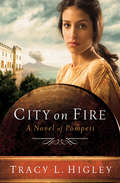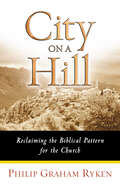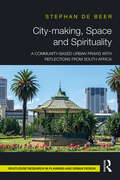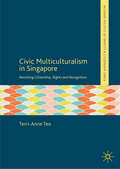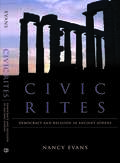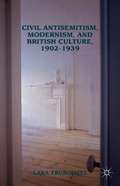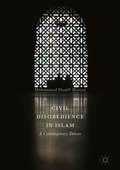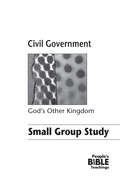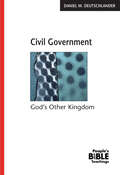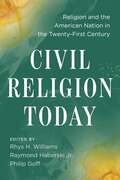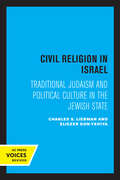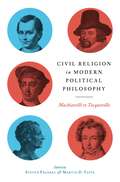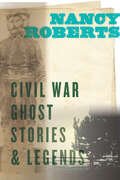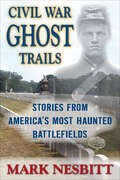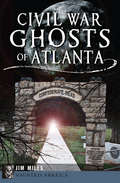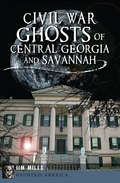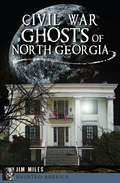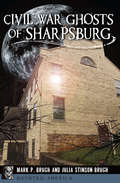- Table View
- List View
City of the Good: Nature, Religion, and the Ancient Search for What Is Right
by Michael Mayerfield BellHow we came to seek absolute good in religion and nature—and why that quest often leads us astrayPeople have long looked to nature and the divine as paths to the good. In this panoramic meditation on the harmonious life, Michael Mayerfeld Bell traces how these two paths came to be seen as separate from human ways, and how many of today’s conflicts can be traced back thousands of years to this ancient divide.Taking readers on a spellbinding journey through history and across the globe, Bell begins with the pagan view, which sees nature and the divine as entangled with the human—and not necessarily good. But the emergence of urban societies gave rise to new moral concerns about the political character of human life. Wealth and inequality grew, and urban people sought to justify their passions. In the face of such concerns, nature and the divine came to be partitioned from the human, and therefore seen to be good—but they also became absolute and divisive.Bell charts the unfolding of this new moral imagination in the rise of Buddhism, Christianity, Daoism, Hinduism, Jainism, and many other traditions that emerged with bourgeois life. He follows developments in moral thought, from the religions of the ancient Sumerians, Greeks, and Hebrews to the science and environmentalism of today, along the way visiting with contemporary indigenous people in South Africa, Costa Rica, and the United States. City of the Good urges us to embrace the plurality of our traditions—from the pagan to the bourgeois—and to guard against absolutism and remain open to difference and its endless creativity.
City on Fire
by Tracy L. HigleyPreviously released as Pompeii.As Vesuvius churns, a slave girl-turned-gladiator joins forces with an unlikely source to seek justice.In the coastal town of Pompeii, a new gladiator prepares to fight. But this gladiator hides a deadly secret: she's a runaway Jewish slave girl named Ariella, disguised as a young boy. A savvy fighter, Ariella determines to triumph in the arena, knowing her life will be forfeit should anyone uncover the truth.Cato, a wealthy politician, moved to Pompeii after tiring of the corruption in Rome. But he soon learns that Pompeii is just as corrupt, and if he doesn't play the game, his family could pay the price. Determined to bring about justice for the citizens of Pompeii, Cato searches for allies. But what he discovers instead is a confounding group of Christians . . . and a young female gladiator whose fame is growing daily.Political unrest reaches a boiling point as Christians are jailed and executed, and the mountain in the distance threatens to destroy the city with its river of fire. Cato and Ariella must act quickly and courageously to save their loved ones before all is lost.
City on a Hill: Reclaiming the Biblical Pattern for the Church
by Philip Graham RykenWe are now living in post-Christian times, when Christianity no longer is the prevailing influence on the mind and heart of our culture. But we cannot compromise. More than ever before, it is imperative that Christians understand and embrace the biblical pattern for the church. Philip Graham Ryken knows that the changing face of America makes the need for the church to remain steadfast even more important. City on a Hill will provide readers with a deeper understanding of how to live for Christ in the twenty-first century: go back to the model set out in the first century. Sure to be an encouragement and challenge to anyone concerned about the effectiveness of the church today.
City on a Hill: Reclaiming the Biblical Pattern for the Church
by Philip Graham RykenWe are now living in post-Christian times, when Christianity no longer is the prevailing influence on the mind and heart of our culture. But we cannot compromise. More than ever before, it is imperative that Christians understand and embrace the biblical pattern for the church. Philip Graham Ryken knows that the changing face of America makes the need for the church to remain steadfast even more important. City on a Hill will provide readers with a deeper understanding of how to live for Christ in the twenty-first century: go back to the model set out in the first century. Sure to be an encouragement and challenge to anyone concerned about the effectiveness of the church today.
City on a Hilltop: American Jews and the Israeli Settler Movement
by Sara Yael HirschhornSince Israel’s 1967 war, more than 60,000 Jewish-Americans have settled in the occupied territories, transforming politics and sometimes committing shocking acts of terrorism. Yet little is known about why they chose to live at the center of the Israeli-Palestinian conflict. Sara Yael Hirschhorn unsettles stereotypes about these liberal idealists.
City-making, Space and Spirituality: A Community-Based Urban Praxis with Reflections from South Africa
by Stéphan de BeerThis book is about the soul of the city, embodied in its spaces and people. It traces dynamics in inner city neighbourhoods of South Africa’s post-apartheid capital, Pretoria. Viewing the city through its most vulnerable people and places, it recognizes that urban space is never neutral and shaped by competing value frameworks. The first part of the book invites planners, city-makers, and ordinary urban citizens, to consider a new self-understanding, reclaiming their agency in the city-making process. Through the metaphor of "becoming like children", planning practice is deconstructed and re-imagined. A praxis-based methodology is presented, cultivating four distinct moments of entering, reading, imagining and co-constructing the city. After deconstructing urban spaces and discourses, the second part of the book explores a concrete spirituality and ethic of urban space. It argues for a shift from planning as technocracy, to planning as immersed, participatory artistry: opening up to the "genius" of space, responsive to urban cries, and joining to construct new, soul-full spaces. Local communities and interconnected movements become embodiments of urban alternatives – through resistance and reconstruction; building on local assets; animating local reclamations; and weaving nets of hope that will span the entire city. Providing a concrete methodology for city-making that is rooted in a community-based urban praxis, this book will be of interest to urban planning researchers, professional planners and designers and also grass-root community developers or activists.
Civic Ceremony and Religion in Medieval Bruges C. 1300-1520
by Andrew Brown"Public religious practice lay at the heart of civic society in late medieval Europe. In this illuminating study, Andrew Brown draws on the rich and previously little-researched archives of Bruges, one of medieval Europe's wealthiest and most important towns, to explore the role of religion and ceremony in urban society. The author situates the religious practices of citizens - their investment in the liturgy, commemorative services, guilds and charity - within the contexts of Bruges' highly diversified society and of the changes and crises the town experienced. Focusing on the religious processions and festivities sponsored by the municipal government, the author challenges much current thinking on, for example, the nature of 'civic religion'. Re-evaluating the ceremonial links between Bruges and its rulers, he questions whether rulers could dominate the urban landscape by religious or ceremonial means, and offers new insight into the interplay between ritual and power of relevance throughout medieval Europe"--
Civic Multiculturalism in Singapore: Revisiting Citizenship, Rights and Recognition (Palgrave Politics of Identity and Citizenship Series)
by Terri-Anne TeoThis book is about multiculturalism, broadly defined as the recognition, respect and accommodation of cultural differences. Teo proposes a framework of multicultural denizenship that includes group-specific rights and intercultural dialogue, by problematising three issues: a) the unacknowledged misrecognition of non-citizens within the scholarship of multiculturalism; b) uncritical treatment of citizens and non-citizens as binary categories and; c) problematic parcelling of group-specific rights with citizenship rights. Drawing on the case of Singapore as an illustrative example, where temporary labour migrants are culturally stereotyped, socioeconomically disenfranchised and denied access to rights accorded only to citizens, Teo argues that understandings of multiculturalism need to be expanded and adjusted to include a fluidity of identities, spectrum of rights and shared experiences of marginalisation among citizens and non-citizens. Civic Multiculturalism in Singapore will be of interest to students and scholars of multiculturalism, critical citizenship studies, migration studies, political theory and postcolonial studies.
Civic Rites: Democracy and Religion in Ancient Athens
by Nancy EvansCivic Rites explores the religious origins of Western democracy by examining the government of fifth-century BCE Athens in the larger context of ancient Greece and the eastern Mediterranean. Deftly combining history, politics, and religion to weave together stories of democracy’s first leaders and critics, Nancy Evans gives readers a contemporary’s perspective on Athenian society. She vividly depicts the physical environment and the ancestral rituals that nourished the people of the earliest democratic state, demonstrating how religious concerns were embedded in Athenian governmental processes. The book’s lucid portrayals of the best-known Athenian festivals—honoring Athena, Demeter, and Dionysus—offer a balanced view of Athenian ritual and illustrate the range of such customs in fifth-century Athens.
Civil Antisemitism, Modernism, and British Culture, 1902–1939
by Lara TrubowitzThis book addresses the development of 'civil' anti-Semitism in twentieth-century Britain, a crucial and often critically neglected strand of anti-Jewish rhetoric that, prior to 1934, was essential to the legitimization of proto-fascist political and literary discourses, as well as stylistic practices within literary modernism.
Civil Disobedience in Islam: A Contemporary Debate
by Muhammad Haniff HassanThis book addresses contemporary debates on civil disobedience in Islam within the rich Sunni tradition, especially during the height of the non‐violent people revolution in various Arab countries, popularly known as the Arab Spring. It illustrates the Islamic theological and jurisprudential arguments presented by those who either permit or prohibit acts of civil disobedience for the purpose of changing government, political systems or policy. The book analyses the nature of the debate and considers how a theological position on civil disobedience should be formulated in contemporary time, and makes the case for alternatives to violent political action such as jihadism, terrorism and armed rebellion.
Civil Government Small Group Study: God’s Other Kingdom
by Thomas KockWhat does the Bible teach about the government? Civil Government by pastor and author Daniel Deutschlander provides you with relevant insights into what the Bible teaches about government. This unique, small-group Bible study by pastors Thomas D. Kock and Ray Schumacher examines each chapter of Civil Government in nine lessons. Each lesson follows an outline: Objective Background Group Discussion Digging Deeper Each lesson also includes brief questions to encourage deep and fascinating group discussions about God's blessings of church and state and the dangers of failing to keep them separate. Note: Having a copy of Civil Government: God's Other Kingdom by Daniel Deutschlander to accompany this Bible study is strongly recommended.
Civil Government: God's Other Kingdom (People's Bible Teachings)
by Daniel M DeutschlanderWhat does church and state mean?The relationship between church and state in America is a tumultuous one, often regarded by Christians as a confusing mess that is best left alone. Yet both the temporal kingdom of civil government and the eternal heavenly kingdom are God’s blessings to us.This book by pastor and author Daniel Deutschlander looks at government as presented during biblical times, traces church-state relations throughout history, and concludes by addressing the current state of affairs in the United States.As you read Civil Government, you’ll learn about the relationship between church and state and be led to the Scriptures to seek principles for guiding and motivating your attitudes and actions!Looking to dig even deeper into church and state? Check out the complimentary small-group Bible study: Civil Government Small Group Study by Thomas D. Kock and Ray Schumacher!The People’s Bible Teachings is a series of books on all the main teachings of the Bible. Following the pattern set by The People’s Bible series, these books are written for all Christians in an easy-to-read manner. The authors of The People’s Bible are all pastors and professors who have had years of experience teaching others about the Bible.
Civil Religion Today: Religion and the American Nation in the Twenty-First Century
by Philip Goff Rhys H. Williams Raymond Haberski Jr.Moves the discussion of American civil religion into the twenty-first century Civil Religion, a term made popular by sociologist Robert Bellah a little over fifty years ago, describes how people might share in a sacred sense of their nation. While hotly debated, the idea continues to enjoy wide application among academics and journalists. Bellah used civil religion to make sense of the turmoil of the 1960s, especially moral debates provoked by the Vietnam War. Now, a half-century later, American society is again riven by conflict over immigration, economic inequality, racial oppression, and “culture wars” issues. Is Bellah's hopeful assessment still useful for understanding contemporary America? If not, how should we think of it differently?Civil Religion Today reassesses the term to take stock of its usefulness after fifty years of engagement in the field. Looking both at the concept and at ground-level studies of how we might find civil religion in practice, this book aims to push the conversation forward, considering how and in what ways it is helpful in our current social and political context, evaluating which parts are worth keeping, which can be reformulated, and which can now be usefully discarded. It suggests we go “beyond Bellah” in theory and practice, thinking about American society in a new century.
Civil Religion in Israel: Traditional Judaism and Political Culture in the Jewish State
by Charles S. Liebman Eliezer Don-yehiyaThis title is part of UC Press's Voices Revived program, which commemorates University of California Press’s mission to seek out and cultivate the brightest minds and give them voice, reach, and impact. Drawing on a backlist dating to 1893, Voices Revived makes high-quality, peer-reviewed scholarship accessible once again using print-on-demand technology. This title was originally published in 1983.
Civil Religion in Modern Political Philosophy: Machiavelli to Tocqueville
by Martin D. Yaffe Steven FrankelInspired by Machiavelli, modern philosophers held that the tension between the goals of biblical piety and the goals of political life needed to be resolved in favor of the political, and they attempted to recast and delimit traditional Christian teaching to serve and stabilize political life accordingly. This volume examines the arguments of those thinkers who worked to remake Christianity into a civil religion in the early modern and modern periods.Beginning with Machiavelli and continuing through to Alexis de Tocqueville, the essays in this collection explain in detail the ways in which these philosophers used religious and secular writing to build a civil religion in the West. Early chapters examine topics such as Machiavelli’s comparisons of Christianity with Roman religion, Francis Bacon’s cherry-picking of Christian doctrines in the service of scientific innovation, and Spinoza’s attempt to replace long-held superstitions with newer, "progressive" ones. Other essays probe the scripture-based, anti-Christian argument that religion must be subordinate to politics espoused by Jean-Jacques Rousseau and David Hume, both of whom championed reason over divine authority. Crucially, the book also includes a study of civil religion in America, with chapters on John Locke, Montesquieu, and the American Founders illuminating the relationships among religious and civil history, acts, and authority. The last chapter is an examination of Tocqueville’s account of civil religion and the American regimeDetailed, thought-provoking, and based on the careful study of original texts, this survey of religion and politics in the West will appeal to scholars in the history of political philosophy, political theory, and American political thought.
Civil Religion in Modern Political Philosophy: Machiavelli to Tocqueville
by Martin D. Yaffe Steven FrankelInspired by Machiavelli, modern philosophers held that the tension between the goals of biblical piety and the goals of political life needed to be resolved in favor of the political, and they attempted to recast and delimit traditional Christian teaching to serve and stabilize political life accordingly. This volume examines the arguments of those thinkers who worked to remake Christianity into a civil religion in the early modern and modern periods.Beginning with Machiavelli and continuing through to Alexis de Tocqueville, the essays in this collection explain in detail the ways in which these philosophers used religious and secular writing to build a civil religion in the West. Early chapters examine topics such as Machiavelli’s comparisons of Christianity with Roman religion, Francis Bacon’s cherry-picking of Christian doctrines in the service of scientific innovation, and Spinoza’s attempt to replace long-held superstitions with newer, “progressive” ones. Other essays probe the scripture-based, anti-Christian argument that religion must be subordinate to politics espoused by Jean-Jacques Rousseau and David Hume, both of whom championed reason over divine authority. Crucially, the book also includes a study of civil religion in America, with chapters on John Locke, Montesquieu, and the American Founders illuminating the relationships among religious and civil history, acts, and authority. The last chapter is an examination of Tocqueville’s account of civil religion and the American regime.Detailed, thought-provoking, and based on the careful study of original texts, this survey of religion and politics in the West will appeal to scholars in the history of political philosophy, political theory, and American political thought.
Civil War Ghost Stories & Legends
by Nancy RobertsThe “First Lady of American Folklore” explores the supernatural side of the Civil War with chilling tales of spectral soldiers and haunted battlefields.Few events have sparked more legends and stories of the supernatural than America’s Civil War. The accounts of gallantry and heroism have spread far and wide. Nancy Roberts grew up listening to her father’s stories of the War Between the States and she trekked over many battle sites with him during her childhood.After reading about General Joshua Chamberlain’s supernatural experience at the Battle of Gettysburg, Roberts began to collect tales of the blue and gray and write them down. In her latest collection, readers visit such famous Civil War sites as Fredericksburg, Antietam, Johnson’s Island, Andersonville, Fort Davis, Gaines Mill, Gettysburg, Fort Monroe, Harpers Ferry, Vicksburg, Richmond, Charleston, New Bern, and Petersburg. Through these stories, the readers will hear the voices of those brave individuals who lived through that dramatic era; visit with Brigadier General J. E. B. Stuart on the banks of the Chickahominy River, learn the real story about John Brown’s activities at Harpers Ferry, and watch the passing of Abraham Lincoln’s funeral train.Praise for Nancy Roberts“Just about everybody likes a good ghost story. And ghost hunter/author Nancy Roberts has put together as shivery a selection of other worldly tales as you’re likely to find anywhere . . . And whether you believe in ghosts or not, these tales are guaranteed to give you a chill, especially before you go into a dark room alone.” —Southern Living
Civil War Ghost Trails: Stories from America's Most Haunted Battlefields
by Mark NesbittRiveting ghost stories with history from all the major engagements of the war.Civil War Ghost Trails examines the major engagements of the Civil War and their connections to the paranormal world. The history of each battlefield is followed by the classic ghost stories that have been around since the guns fell silent. Mark Nesbitt also collected newer stories and attempted a paranormal investigation, including Electronic Voice Phenomena (EVP), at many of the sites to see what could be found. In some cases, the results were astounding. Some of the spirits included in the book are the Headless Zouave at Bull Run, the Drummer Boy at Shiloh, and the Phantom Battalion at Gettysburg. Ghosts appear at the Bloody Lane at Antietam and Caroline Street in Fredericksburg, as well as sites at Chancellorsville, Vicksburg, Chickamauga, Chattanooga, Petersburg, and Appomattox Court House. A special section of the book explores the haunted Civil War prisons at Johnson&’s Island in Ohio, Point Lookout in Maryland, and Andersonville in Georgia. Abraham Lincoln&’s many White House apparitions are discussed in a section on wartime Washington, D.C.
Civil War Ghosts of Atlanta (Haunted America)
by Jim MilesThe author of the Civil War Explorer series unearths the ghostly legends and lore that haunt Georgia&’s capital city since the War Between the States. The Atlanta metropolis is one of America&’s most modern and progressive cities, it&’s easy to forget that 150 years ago it was the scene of a long and deadly campaign. Union general William T. Sherman hammered relentlessly against Atlanta at Kennesaw Mountain, Peachtree Creek, Ezra Church, and Jonesboro. Months later, as he began his infamous March to the Sea, much of Atlanta was destroyed by fire. Thousands died in the fighting, and thousands more succumbed to wounds and disease in large hospitals constructed around the city. Today, ghosts of Atlanta&’s Civil War haunt battlefields, hospital sites, cemeteries, homes, and commercial structures, all a testament to the tragic history of the city. Join author Jim Miles as he details the Civil War spirits that still haunt Atlanta. Includes photos! &“He&’s a connoisseur of Georgia&’s paranormal related activity, having both visited nearly every site discussed in his series of Civil War Ghost titles . . . Miles has covered a lot of ground so far from the bustling cities to the small towns seemingly in the middle of nowhere. This daunting task takes an inside look to the culture and stories that those born in Georgia grow up hearing about and connect with.&” —The Red & Black
Civil War Ghosts of Central Georgia and Savannah (Haunted America)
by Jim MilesThe historic battlefields of central Georgia and Savannah ensure that the state&’s Civil War ghosts shall rise again . . . and again . . . and again . . . The Heartland of Georgia, a vast region stretching from Columbus to Savannah and from the edge of Atlanta to Florida, is home to historic sites of Sherman&’s March to the Sea and Andersonville Civil War Prison. Because of this history, the area is one of the most haunted in the United States. All manner of paranormal phenomena haunt the battlefields, houses, prison sites, and forts throughout this region. Spirits even stalk the streets of Savannah, one of the most haunted cities in the world. Join author and historian Jim Miles as he details the past and present of the ghosts that haunt central Georgia and Savannah. Includes photos! &“He&’s a connoisseur of Georgia&’s paranormal related activity, having both visited nearly every site discussed in his series of Civil War Ghost titles . . . Miles has covered a lot of ground so far from the bustling cities to the small towns seemingly in the middle of nowhere. This daunting task takes an inside look to the culture and stories that those born in Georgia grow up hearing about and connect with.&” —The Red & Black
Civil War Ghosts of North Georgia (Haunted America)
by Jim MilesThe author of Haunted North Georgia stalks the Civil War ghosts that populate the top of the Peach State. Though Georgia was spared the hard hand of war for two years, combat arrived with a vengeance in September 1863 with the Battle of Chickamauga in north Georgia. It was the second largest battle of the Civil War and has become one of America&’s most haunted battlefields, producing a long history of bizarre paranormal events that continue today. From Sherman&’s notorious march to Confederate general James Longstreet&’s continued inhabitance of his postwar home, Georgia is haunted by many of those who fought in America&’s deadliest war. Join author Jim Miles as he details the ghosts that still roam Georgia&’s Civil War battlefields, hospitals, and antebellum homes. Includes photos! &“He&’s a connoisseur of Georgia&’s paranormal related activity, having both visited nearly every site discussed in his series of Civil War Ghost titles . . . Miles has covered a lot of ground so far from the bustling cities to the small towns seemingly in the middle of nowhere. This daunting task takes an inside look to the culture and stories that those born in Georgia grow up hearing about and connect with.&” —The Red & Black
Civil War Ghosts of Sharpsburg (Haunted America)
by Julia Stinson Brugh Mark P. BrughThe Maryland town devastated by the bloodiest day of the Civil War—the Battle of Antietam—is now home to its ghostly victims. In September 1862, fighting from the Battle of Antietam spilled into Sharpsburg&’s streets. Residents were left to bury the dead from both sides. Today, locals report lingering echoes of that strife, from the faint taps of a Union drummer boy named Charley King to the phantom footsteps of Confederate soldiers charging up the stairs of the Rohrbach House. Two spectral girls seen playing by the Big Spring in Children&’s Alley may be Savilla Miller and Theresa Kretzer, best friends torn apart by their divided loyalties. Tour guides Mark P. Brugh and Julia Stinson Brugh craft a vivid portrait of Sharpsburg in the Civil War and bring to light stories of the ghosts for whom the conflict never ended. Includes photos! &“Folklore, social history, and a haunted village . . . Provides brief discussions of the historic architecture and ironwork of the village and sketches of the effects of battle upon the civilian population . . . Overall, the authors have set the folklore of hauntings with the context of a major historical event.&” —Civil War Librarian
Civilizations of the Holy Land
by Paul JohnsonFrom the book's introduction: "'civilizations of the holy land' is an expression not easily defined in either space or time. By the Holy Land, most of us mean the stretch of Near-Eastern territory, the nucleus of which is modern Palestine or Israel, intimately associated with the great 'Religions of the Book', Judaism, Christianity and Islam. Many of the events crucial to the origin and early development of these three faiths took place outside this geographical nucleus but cannot for that reason be ignored in this account. Equally, not all the cultures which have flourished in this region have been directly linked to the beliefs which, to us, make it holy but they are part of its history nonetheless, and must be brought into the story. The truth is that the history of this corner of the world is extremely complicated and does not easily accommodate itself to the straitjacket of a strictly systematic treatment. In telling it we shall sometimes find ourselves digressing both in chronology and geography before resuming the main thread of our narrative. In short, we shall be closer to the methods of Herodotus than those of Thucydides - with a dash of Pausanias and Strabo thrown in. No matter: what the tale loses in clarity it may gain in colour." History buffs and students of the Bible and Koran would find this book fascinating. The understanding of either book will be enhanced by knowing the history and culture behind those books and the places of worship which they inspire. From Canaaites to Crusaders. Very readable.
Civilization’s Last Hurrah
by Gary G. CohenCivilization's Last Hurrah is a Bible prophecy novel. That is, it attempts to show in a fictional story just how the events prophesied for the end of this age may actually unfold. The reader must understand that while many of the coming great events of Bible prophecy are quite clearly explained in the Scriptures, yet numerous details still remain a mystery to us today. In this book the author has hazarded his own opinions-- often guesses-- as to how some of these details will actually occur.

